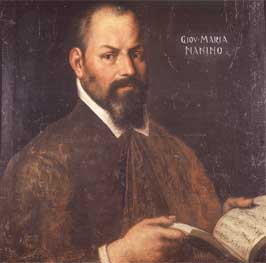Giovanni Maria Nanino facts for kids
Giovanni Maria Nanino (sometimes spelled Nanini) was an Italian composer and music teacher. He was born in 1543 or 1544 and passed away on March 11, 1607. Nanino lived during the late Renaissance period. He was an important member of the Roman School of composers. He was also known as the most influential music teacher in Rome during the late 1500s. His younger brother, Giovanni Bernardino Nanino, was also a composer.
A Musician's Life
Giovanni Maria Nanino was born in Tivoli, a town in Italy. When he was a boy, he sang as a boy soprano in the cathedral at Viterbo. In the 1560s, he likely studied music with Palestrina. This was at the church of San Luigi de' Francesi in Rome. After Palestrina left, Nanino became the maestro di cappella there. This means he was the music director.
In 1577, Nanino joined the papal choir as a tenor singer. He stayed in this choir for the rest of his life. Sometimes, he would take turns as the maestro di cappella for the choir.
Nanino as a Teacher
During the 1590s, Nanino became very famous as a teacher. He and his brother started what many believe was the first public music school in Rome run by Italians. Many future composers learned from him. They also sang in his choirs. Some of his well-known students included Felice Anerio, Antonio Brunelli, Antonio Cifra, and Gregorio Allegri. Allegri is famous for his piece called Miserere.
Nanino's Musical Works
Nanino did not write a huge amount of music. However, his compositions were very special. His music, especially his madrigals, was extremely popular at the time. Madrigals are a type of vocal music, usually for several voices without instruments.
Almost every collection of madrigals published in Rome included at least one of Nanino's pieces. Often, his madrigal was placed in the most important spot in the book. This was even ahead of works by Palestrina. His madrigals showed a wide range of styles. They varied from very serious and complex pieces to lighter, simpler songs called canzonette. Some people compare his expressive music to that of Luca Marenzio, another famous composer.
Besides his popular madrigals, Nanino also wrote other types of music. These included motets, which are sacred choral pieces. He also wrote settings of the Lamentations and canons. Canons are pieces where a melody is repeated by different voices or instruments. He also composed other sacred songs. As of 1980, a full collection of his works had not been put together. Much of his music still existed only in handwritten copies.
See also
 In Spanish: Giovanni Maria Nanino para niños
In Spanish: Giovanni Maria Nanino para niños


